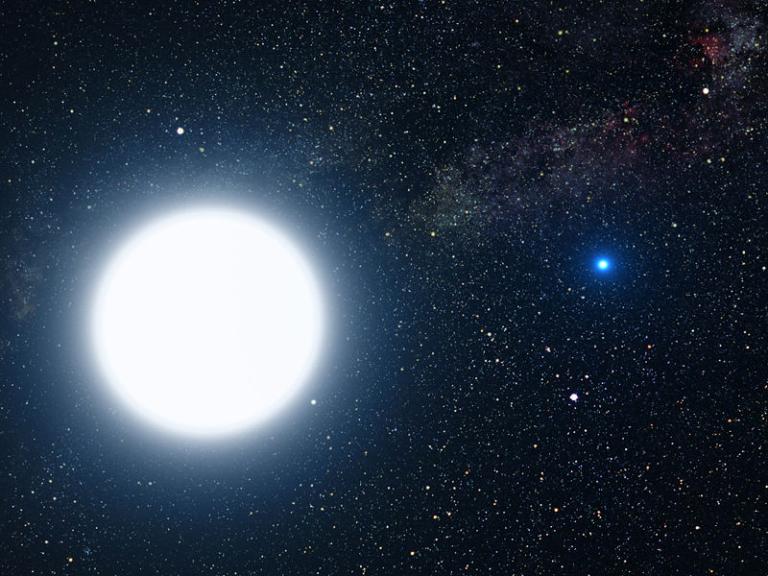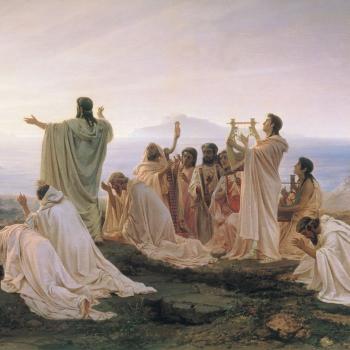
(Wikimedia Commons public domain image)
Few readers are surprised, probably, to learn that the name Sahara is Arabic (it means “deserts”), but the extent of our debt to the Arabs in the field of navigation and geography is shown by such Arabic terms as nadir, zenith, and azimuth, which still form an important part of those disciplines in our own language. Even weather terms like monsoon (mawsim, “season”) and scirocco—probably more familiar as the name of an automobile than in its original meaning of “the east wind” (sharqi)—come to us from the Arabs.[1] (The same Arabic term for eastern, sharqi, is the source for the name by which the Crusaders called their Muslim opponents in the Middle Ages: Saracens.)[2]
In the physical sciences, the Arab Ibn Haytham came to an essentially modern view of the nature of human vision in the tenth century by rejecting the incorrect views of Euclid and Ptolemy. (The question of how external objects come to form images within our minds is a very difficult one. The solution is not at all obvious.) Ibn Haytham’s work on the principles of optics also led him to a theory of what makes rainbows. In the thirteenth century, a scientist by the name of Kamal al-Din concluded, correctly, that the speed of light, although great, cannot be infinite. (We know this now, but, again, it is hardly obvious.) Our term alchemy furnishes an important clue to the connection of that discipline, and of chemistry in general, with the Arabs. The term al-kimiya is the Arab word for both alchemy and chemistry. (The “al-” prefix is simply the article the. We have borrowed it in Arabic-English words like alfalfa and albatross and alcatraz.)[3] As Arabic chemical treatises began to enter Western languages, so, too, did items of Arabic chemical vocabulary such as alembic, alkali, benzene, camphor, elixir, talc, and talcum.[4] Ironically, the word alcohol also comes to us from the Arabs—most of whom, as Muslims, do not (or, anyway, should not) drink “alcoholic” beverages. In Arabic the word al-kohl (“the powder”) refers to a substance known in English as antimony or even, borrowing the Arabic term directly, as kohl; it is commonly used by Arab women as a cosmetic, to darken their eyelids.
The Arabs were also adept at engineering. In hydraulics, the Abbasid dynasty was already thinking of constructing a Suez canal, connecting the Mediterranean Sea with the Red Sea. Unfortunately, they had to give the idea up . It was only finally completed, to the huge benefit of the region, in the nineteenth century. (Giuseppi Verdi’s popular Egyptian opera Aida was composed to commemorate the great event.) The waterwheel, invented by the Arabs, was brought to Europe by the Crusaders and played an important role in Western economic development. One of the most famous creations of Arab technical expertise was a mechanical tree with silver and gold birds that dazzled ambassadors of the Byzantine emperor Constantine VII, who were visiting the court of al-Muqtadir at Baghdad in 917 A.D.
A representative figure for general Arab science in the medieval period might be al-Biruni (d. 1048), whom the famous Western historian of science George Sarton calls “one of the greatest [scientists] of all times …His critical spirit, toleration, love of truth, and intellectual courage were almost without parallel in medieval times.”[5] Very few in the West have heard of him, but he was perhaps the first person to make an accurate determination of latitude and longitude. He discussed the possible rotation of the earth on its axis six centuries before Galileo did. And, an example of his wide-ranging interests, he studied Sanskrit and composed a very accurate and objective History of India.
And now a note on Islamic astronomy and calendrics:
The very size and extent of the Islamic world was a great help in astronomical research. Observations from widely separated points were written up in Arabic, the great scientific language of the day, and could be compared by scientists living thousands of miles apart. Muslims, Christians, and even Chinese astronomers were collaborating at the great observatory of Maragheh, in northwestern Iran, by medieval times.
Our debt to Arab astronomy is shown in the large number of Arabic star names that have entered our own astronomical lore. A few examples should be enough to make the point. The name of the star Aldebaran, for instance, means “the one behind,” and comes from the fact that, in the Arab view, it was situated behind the constellation known to us as the Pleiades. Vega, the fifth brightest star in the night sky, bears a distorted Arabic name, which may be a little bit easier to understand if we recall that the letter v in Latin, the language of medieval Western science, is pronounced like the English w: classical Arab astronomy knew Vega as al-waqi, “the faller,” or, in a more complete phrase, as al-nasr al-waqi, “the falling eagle.” The constellation of the “Twins,” known to us as Gemini, is called al-jawza by the Arabs. Betelgeuse, the oddly named star that showed up a few years ago in an astonishingly bizarre Hollywood movie, is one of the stars at the top of Gemini. The Arabs called it bat al-jawza, meaning “shoulder of the twins.” The star Deneb forms the tail of the constellation Cygnus, or the “Swan.” Its name in Arabic means “tail.” The name of Altair, the twelfth brightest star visible from earth, is Arabic for “the flier.” Fomalhaut, another strangely-named star that is the eighteenth brightest in the sky, is part of the constellation known as Pisces, or the “Fish”; its Arabic name means “mouth of the fish.” Algol, which we now know to actually be two stars revolving around each other, fluctuates in brightness approximately every three days as the brighter of the two stars is eclipsed by the dimmer one. This strange variation in brightness, easily visible to the naked eye, may have been a reason that led the Arabs to call it “the demon.” (Our word ghoul comes from the same source; in early Arabian lore, a ghul was a desert demon who appeared in varying shapes.) Rigel, the seventh brightest star in the sky, is one of the feet of the constellation known to us as Orion the Hunter; in Arabic, rijl means “foot.”[6]
A field closely related to astronomy is calendrics, the making of calendars. It is not easy, since the earth is unfortunately uncooperative and does not revolve around the sun in precisely 365 days— to say nothing of other complications. Here, a major figure is Omar Khayyam, who is best known in the West as the author of the famous Rubaiyat, translated into English by Edward Fitzgerald. But Omar Khayyam is not particularly well known in his native Iran as a poet. Instead, he is regarded as a great mathematician and astronomer. And justly so. His calendar loses only one day in 5000 years, whereas the Gregorian calendar that we currently use in the West loses one day in 3500 years.
Our English word almanac has a colorful derivation. Today it can refer to an annual publication on sports or theater or almost any subject, but its original English usage—as in Poor Richard’s Almanach, published by Benjamin Franklin—was for an annual publication that included a calendar with times of sunrise and sunset, astronomical data, and other miscellaneous information. The presence of the “al-“ is a hint that almanac might be connected with the Arabs, and, in fact, it is. The Arabic root n-w-kh is related to kneeling. A noun derived from this root, munaakh, originally meant a “halting place,” “a place where camels kneel down.” Soon, it came to mean a “place of residence.” Then it began to refer to the quality of that place and especially to its weather. Thus, today, the word munaakh or manaahh can mean, simply, “weather” or “climate.” And it is from this, the idea of kneeling camels, that we have today’s almanacs.
[1] It has even been argued that our word typhoon comes from Arabic tufan (“flood,” “inundation,” “deluge”), but I think this must be rejected.
[2] I’m tempted to suggest, for the benefit of fellow fans of J. R. R. Tolkien’s trilogy The Lord of the Rings, that the undignified nickname given at the end of the story to the fallen wizard Saruman—”Sharkey”—may also be related to the Arabic sharqi, “Easterner.” After all, throughout the trilogy “the West” is good and “the East” is bad. Tolkien was a medievalist, and his good friend C. S. Lewis indisputably borrowed a modified form of the Turkish word arslan, “lion,” as the name of the hero of his Chronicles of Narnia. Other commentators have claimed that Sharkey derives from the Orkish sharhu, “old man.” Both theories may be right.
[3] In terms of their origin, albatross and alcatraz are the same word. Both go back to the Arabic al-qadus, meaning “waterwheel bucket,” “scoop,” or “waterbearer.”
[4] Some have suggested an Arabic etymology for the word lava, but this appears doubtful.
[5] George Sarton, Introduction to the History of Science, 2 vols. (Washington: Carnegie Institution of Washington, 1927), 1:707.
[6] Some students of the Book of Abraham, including the present author, have been tempted to propose that the great star Kolob, referred to in Abraham 3, may be linked in some way with the visible star Sirius. Sirius is, by a considerable distance, the brightest star in the night sky. It has been widely known since ancient times as the “Dog Star.” The Hebrew equivalent of the English dog is kelev or keleb; the Arabic equivalent is kalb.












